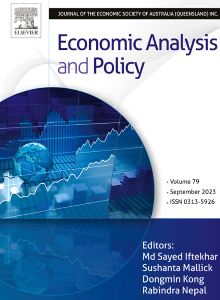Beyond electricity: The welfare effects of a residential electricity cash transfer in Vietnam
IF 8.7
2区 经济学
Q1 ECONOMICS
引用次数: 0
Abstract
Access to adequate electricity remains a challenge for poor households in many developing countries due to affordability constraints. Since 2011, the Vietnamese government has implemented a nationwide cash transfer program aimed at supporting electricity consumption among low-income households. Using panel household survey data and household fixed-effects models, we assess how this transfer affects the electricity consumption and household welfare of recipients. Overall, we find no significant effect of the transfer on electricity consumption for most beneficiaries, consistent with electricity’s low income elasticity and indicating that it is a necessity good. However, we find two important results. First, while the transfer has no significant effect on electricity consumption for recipients as a whole, it has a positive and significant effect for ultra-poor households. This suggests that electricity use among the ultra-poor is constrained more by liquidity limitations than by a lack of demand. Second, we find that recipient households reallocate part of the transfer toward education and other non-food needs, subsequently contributing to a reduction in expenditure-based poverty. This finding highlights the fungibility of income and suggests that subsidy design should take into account liquidity constraints and households’ consumption preferences.
电力之外:越南居民电力现金转移的福利效应
由于负担能力的限制,获得充足的电力仍然是许多发展中国家贫困家庭面临的一个挑战。自2011年以来,越南政府实施了一项全国性的现金转移支付计划,旨在支持低收入家庭的电力消费。利用面板家庭调查数据和家庭固定效应模型,我们评估了这种转移如何影响电力消耗和受援者的家庭福利。总体而言,我们发现转移对大多数受益人的用电量没有显著影响,这与电力的低收入弹性一致,表明它是一种必需品。然而,我们发现了两个重要的结果。首先,虽然转移支付对受助人的整体用电量没有显著影响,但对超贫困家庭却有积极显著的影响。这表明,极度贫困人口的用电更多地受到流动性限制的制约,而不是缺乏需求。其次,我们发现受助家庭将部分转移支付重新分配给教育和其他非食品需求,从而有助于减少基于支出的贫困。这一发现强调了收入的可替代性,并建议补贴设计应考虑流动性约束和家庭消费偏好。
本文章由计算机程序翻译,如有差异,请以英文原文为准。
求助全文
约1分钟内获得全文
求助全文
来源期刊

Economic Analysis and Policy
ECONOMICS-
CiteScore
9.80
自引率
9.20%
发文量
231
审稿时长
93 days
期刊介绍:
Economic Analysis and Policy (established 1970) publishes articles from all branches of economics with a particular focus on research, theoretical and applied, which has strong policy relevance. The journal also publishes survey articles and empirical replications on key policy issues. Authors are expected to highlight the main insights in a non-technical introduction and in the conclusion.
 求助内容:
求助内容: 应助结果提醒方式:
应助结果提醒方式:


